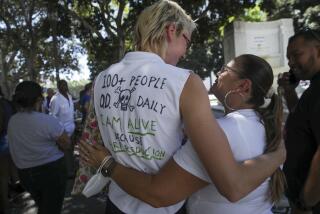Deaths From Smoking Still Increasing
- Share via
Programs to achieve federal government goals of controling cancer by the year 2000 remain a “qualified failure,” according to a prominent UCLA expert who argues in a new analysis that smoking-related cancers in people 55 and older are likely to overwhelm progress against all other types of the disease in every other age group.
In the face of this emerging reality, contended Dr. Lester Breslow, of UCLA’s Jonsson Comprehensive Cancer Center, the government’s National Cancer Institute must again confront an argument it has heard a lot in the past few years: That it spends too much, proportionately, on hard science research and not enough on prevention.
Tobacco-Related Cases Up
In the first breakdown of its type, Breslow and UCLA statistician William Cumberland produced cancer death-rate trend data for 11 age groups, plotted between 1950 and 1984. The figures show that there is reason for optimism in progress against cancer in patients 54 and younger. But trends in tobacco-related cancers among people 55 and older have been so dramatically lethal that the nation’s overall cancer death rate has steadily increased.
In people 25 to 34, the data shows, the cancer death rate has dropped from 20 per 100,000 population to 13. In the 35- to 44-year bracket, the rate was down from 62.7 deaths to 46.6. But by 1984, people 55 to 64 were dying of cancer at a rate significantly greater than in 1950--448.4 deaths compared to 392.9. There were similar increases in three other age brackets up to 85 and older.
In all, the steady increase in tobacco-related cancer fatalities and in fatalities in specific age groups drove the national death rate up from 124.4 deaths per 100,000 in 1950 to 133.5 in 1984.
It was the observation of this overall increase--despite President Nixon’s declaration of “war” on cancer in the 1970s--that prompted Harvard University researchers to charge in 1986 that if it’s a war, “we are losing.”
The Breslow and Cumberland study appears as an article today in the Journal of the American Medical Assn. In it, Breslow concludes that “a shift in research emphasis, from research on treatment to research on prevention, seems necessary if substantial progress against cancer is to be forthcoming.”
‘Political Problem’
Breslow urged a change in Cancer Institute spending priorities. He said the amount spent by the NCI on prevention and control--about $60 million a year--”ought to be multiplied several times so that prevention programs represent far more than the 4% they now do of total federal government cancer expenditures.”
“In a sense, it’s a political problem,” Breslow said.
But in a medical context, he said, the new analysis identifies a stark reality: “There is no doubt that the increase in cancer mortality beyond age 55 is due entirely to the epidemic of lung cancer. We know that 30% of all cancer now is attributable to tobacco, so if we solve that problem (of tobacco use), we would solve 30% of the whole problem.”
In the new analysis, Breslow and Cumberland criticized both major statistical methods commonly used in recent years to evaluate progress in the cancer fight. The first depends on monitoring trends in the overall cancer death rate; the second computes, based on a complex statistical formula, the number of years of useful life that are lost because victims die early.
Good News, Bad News
Charting a new, age-specific breakdown of the latter, Breslow said, the UCLA team found reason for increasing optimism among people born after 1935 but a significant worsening of the cancer odds faced by people born earlier.
NCI director Dr. Vincent DeVita said that, even though the UCLA team criticizes the institute’s spending priorities, Breslow’s conclusions about age groups that face increasingly grim cancer prospects are clearly correct.
“The only disappointing part of it,” DeVita said in a telephone interview, “is the implication that we’re not doing anything (in prevention). Prevention is a risky business. I don’t think at the present time there is a single method of preventing cancer that is not being exploited by the institute.
“Maybe we should do twice as much. We can’t match the advertising budget of tobacco companies. But the implication that these (prevention) programs are not going on is unfortunate. I think it’s rather startling to people to see that, without discovering anything new, you can do a lot more than we’re doing.”
Agreement With Conclusions
Dr. John Bailar, the Harvard researcher who produced the 1986 study that questioned the broad array of optimistic conclusions by the NCI, and the private American Cancer Society said that while Breslow’s conclusions do not reflect his own broader pessimism about the war on cancer, he agrees with the new study.
“We found that there had been very little impact, overall, of all the research activity and other (anti-cancer initiatives) over several decades,” Bailar said, “and I think Dr. Breslow does not in any way disagree.”
But aside from endorsing greatly expanded anti-smoking campaigns, Bailar said he is not yet convinced that prevention programs and strategies are well focused enough yet for their results to be anything close to certain in the future.
“I don’t think the payoff (from an expanded focus on prevention) is likely to come soon except in the field of reduced cigarette smoking,” he said.
More to Read
Sign up for Essential California
The most important California stories and recommendations in your inbox every morning.
You may occasionally receive promotional content from the Los Angeles Times.













